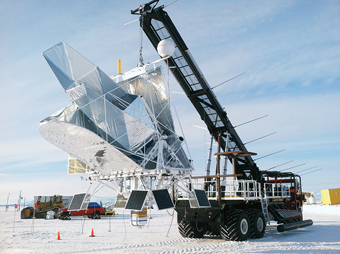The universe started with the big bang some 13.7 billion years ago. But the details of what happened slightly after “time zero” are murkier: Was there a period of “inflation” moments after the beginning of the universe? Inflation can explain why the universe appears as it does today – with clusters of galaxies spread out smoothly in all directions – but so far there’s been no direct confirmation of the theory. Evidence for inflation may finally be at hand, however, thanks to an ambitious balloon-borne set of telescopes to be launched from Antarctica this winter.
The project, known as SPIDER, will give scientists a new look at the cosmic microwave background, sometimes described as the “echo” of the big bang. This microwave background is more than 13 billion years old – but as ancient as it is, it may hold clues from an even earlier epoch. By studying how the individual light waves are oriented – that is, their polarization – physicists believe they can learn about the era of cosmic inflation, a fleetingly brief period when the universe underwent an exponential growth spurt, in the first moments after its fiery birth.
“We have the potential to learn something about what was happening in the universe a tiny fraction of a second after the big bang,” explains astronomy professor Barth Netterfield, who leads the U of T team working on SPIDER. About a dozen other institutions from Canada, the U.S., the U.K. and South Africa are also collaborating on the project, but U of T scientists make up one of the largest contingents, designing the main SPIDER structure, its pointing system (vital for keeping it aimed at the particular patch of sky that it’s studying), and much of the electronics. (SPIDER is not an acronym: “It’s just the formal name of the project,” explains Jamil Shariff, one of the U of T graduate students working on the telescope. “We decided to write it in all caps, somewhat arbitrarily.”)
Because the earth’s atmosphere absorbs much of the radiation they’re trying to study, scientists need to peer above it – and so SPIDER, about the size of a large SUV, will be lifted into the stratosphere by a giant helium balloon. Then its array of six telescopes, each containing several hundred individual detectors, will scan the sky, examining the detailed structure of the cosmic microwave background. A few weeks later, when the experiment is complete, the detectors (and the vital, data-filled hard drives) will be returned to earth by parachute. The project brings “an enormous increase in sensitivity” compared with earlier experiments, Netterfield says.
The inflation model of the big bang, dating from the 1980s, is the leading theory for explaining our cosmic origins. But if inflation happened, it should have unleashed a flood of gravitational waves – ripples in the fabric of space-time, predicted by Einstein’s general theory of relativity, but never directly observed. These waves may have left their imprint in the cosmic microwave background, distorting it in a particular way – similar to the way ripples on a pond would distort one’s view of the rocks below.
Earlier this year, scientists involved with another cosmology experiment announced that they had observed these gravitational waves using a ground-based telescope – but that turned out to be premature; the team now says that the patterns they were seeing could just as likely be caused by interstellar dust as by the much sought-after gravitational waves. (“Stardust got in their eyes,” as a writer for The New York Times put it.) With its greater sensitivity, SPIDER should be able to distinguish the two effects – the gravitational waves, and the dust – and provide compelling evidence for the inflation theory. (That is, assuming the waves are out there waiting to be found.)
If SPIDER succeeds, it will be a big thumbs-up for inflation, and also the closest that scientists have peered toward “time zero.” “The universe was so different then,” says Netterfield. “It’s right at the edge of physics.”






